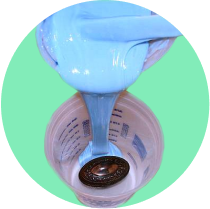
MoldGel Alginate SILFREE - Regular Set 4-5 Min Set
MoldGel SILFREE-RegSet - is silica free and made with food grade ingredients. Our alginate mixes easily into a smooth, creamy consistency providing forensic detail down to the fingerprints.
READ How Alginate Is Made
The Healthiest -- Most Environmental Friendly Mold Making Impression Material Alginate Available
HIGHLIGHTS:
- Health Friendly – Silica-free and dustless, too!
- Environmentally GREEN – with all food grade ingredients
- Highest Yielding Formula – greatest value ounce-for-ounce
- Delayed Shrinkage – extends casting time requirements up 24-hrs.
- Ultra Smooth and Creamy – reduces mold voids due to air bubbles
- Stays In Place – improved surface tension reduces runs
- Gradual Set Time – eliminates a setting surprise
- Surface Enhanced – improved gypsum and fast resin compatibilty
- Approved for ASTM D-4236 Labeling – independently tested
It is the healthiest, earth friendliest, most shrink resistant hydrocolloid impression material of its kind to date and . . . and provides 20-50-percent greater yields over traditional blends.
The new formula is both crystalline silica-free (OSHA recommends elimination of this potential hazard in the work place) and dust free eliminating inhalation hazards during dispensing. It is also fluoride free and ‘lead free’ which other formulas cannot represent. With all of these safety improvements it is by far the healthiest formula to use.
The new filler along with the other food grade components enriches the soil when discarded. This earth friendly product now makes disposing of used material not only a simple matter, but CO2 reducing, too. It actually helps in the fight against global warming and promotes clean air by nurturing carbon dioxide eliminating and oxygen producing plants.
Yet higher quality doesn’t mean higher cost. Intriguingly, the new formula holds more water in suspension than the old mixes which creates greater yields of impression material per pound. This means each pound of the improved mold powder when combined with water yields up to 50-percent more impression material compared to current formulations.
As an example with its 7-to-1 mix ratio by weight (water to powder) it yields more than twice as much impression material as brands that offer only 3-to-1 mix ratios. But, that is not all. The new discovery not only improves mold detail without the use of more toxic fluoride salts, but its innovative ingredients contain a cell structure that delays mold shrinkage by enabling it to hold water far longer than similar impression materials. With delayed shrinkage casting can be postponed to a more convenient time while still retaining all the original detail that would normally be lost with current blends.
When your mold is no longer needed just crumble it up and add it to the soil or the compost pile as a supplement to foster plant growth. More importantly a high quality mold is assured every time through an improved manufacturing process that guarantees an ultra smooth and creamy, lump-free consistency.
The advanced formula has been evaluated by Info Tox. International, Inc., a toxicology, occupational safety and environmental health testing lab and consulting company based in Riverside, California and has been certified: ‘Approved Conforming to ASTM D-4236.’
MIXING AND CURING: Weigh or measure proper amounts of MoldGel SILFREE Regular Set powder and 80° F. / 27° C water. Mix together rapidly, but avoid whipping in air. A turbo mixer on a variable speed drill is recommended. Thicken with more powder, thin with more water. Apply to surface with a flowing motion pushing air out ahead of material. Optional liquid retarder may be premixed with water to extend working time. See chart.
MoldGel will not bond to itself unless the previous mix is not completely set. Thus, a large mold requiring more than one mix should be made by mixing a series of mixes within five minutes of one another. Bonding can be accomplished on gelled MoldGel by spraying or painting Algislo on the surface of the mold material.
You can also embed fiber into MoldGel to secure the shell. As soon as MoldGel is firm, mix and apply a mother mold using plaster bandages or cheesecloth and diluted plaster. When plaster shell is set, remove the mold. It is recommended that a positive casting be made within 12-hours, as MoldGel SilFree will begin to loose detail as it dries.
ArtMolds offers three variations to its new formula . . . Hollywood Impressions® SILFREE with a 2-3 minute set time in 80-degree F. (27-degrees C.) water. It is tinted green and an attractive lime scented. MoldGel® SILFREE Regular Set has a 4-5 minute set time with an orange tint and a pleasant orange fragrance. Then there is MoldGel® SILFREE SloSet with a 7-8 minute set time and is blue tinted with a peppermint candy scent.
Available in the following sizes: 1-lb, 10-lb, 20-lb and 50-lb. Select size below.













